
Guests
- Sonia NazarioPulitzer Prize-winning journalist and author of Enrique’s Journey: The Story of a Boy’s Dangerous Odyssey to Reunite with His Mother.
- Jose Luis Zelayafled his home in Honduras at the age of 13 in search of his mother. He traveled unaccompanied through Central America and finally reached Houston, Texas, four months later. He’s currently a Ph.D. student a Texas A&M in the Department of Education. Zelaya is part of the Council for Minority Student Affairs at Texas A&M and a member of the immigrant rights group United We Dream.
U.S. Customs and Border Protection reports over 47,000 unaccompanied children have been detained so far this year after crossing the border, almost double the number for all of 2013 and almost five times the number from 2009. President Obama has described the situation as a “humanitarian crisis.” Some of the children have been detained in shocking conditions. Over 1,000 children are reportedly being held at a warehouse in Nogales, Arizona, some sleeping in plastic containers. We speak to Jose Luis Zelaya, who fled Honduras in 2000 at the age of 13 in search of his mother. He traveled unaccompanied through Central America and finally reached Texas four months later. Zelaya is now a Ph.D. student at Texas A&M in the Department of Education. We also speak to Sonia Nazario in Los Angeles, California. She is a Pulitzer Prize-winning journalist and author of “Enrique’s Journey: The Story of a Boy’s Dangerous Odyssey to Reunite with His Mother.”
Transcript
AMY GOODMAN: A coalition of immigration and civil rights groups has filed a complaint alleging widespread and systemic abuse of migrant children by U.S. Customs and Border Protection. Organizations including the National Immigrant Justice Center and the ACLU say they’re acting on behalf of over 100 unaccompanied children mistreated by border agents after crossing into the United States. So far in 2014, U.S. Customs and Border Protection reports over 47,000 unaccompanied children have been detained after crossing the border, almost double the number for all of 2013, almost five times the number from 2009. President Obama has described the situation as a “humanitarian crisis.”
A number of the children have been detained in shocking conditions. Over a thousand children are reportedly being held at a warehouse in Nogales, Arizona, some sleeping in plastic containers. On Thursday, The Washington Post posted video showing makeshift holding areas for detained migrants at the McAllen, Texas, Border Patrol station. The video shows dozens of women and children sprawled on concrete floors.
Earlier this week, Democracy Now!’s Nermeen Shaikh and I spoke to two guests about the plight of these migrant children. In Houston, Jose Luis Zelaya, who fled Honduras in 2000 at the age of 13 in search of his mother—he traveled unaccompanied through Central America and finally reached Texas four months later. Zelaya is now a Ph.D. student at Texas A&M in the Department of Education, part of the Council for Minority Student Affairs at Texas A&M and a member of the immigrant rights group United We Dream.
We also spoke to Sonia Nazario in Los Angeles. She is a Pulitzer Prize-winning journalist, author of Enrique’s Journey: The Story of a Boy’s Dangerous Odyssey to Reunite with His Mother. I started by asking Sonia Nazario about the number of migrant children being warehoused in United States right now.
SONIA NAZARIO: Well, this surge, as it’s called, really started in 2011. We’ve seen over the last three years a tenfold increase in the number of children coming here unaccompanied, unlawfully and being placed in federal custody. And that doesn’t even count the Mexican children, nearly 20,000 of those additionally, who are deported within 24 or 48 hours. These are mostly children from Central America, from Honduras, El Salvador, Guatemala, and there’s just been this enormous surge. Last month, in one day, we saw a thousand children placed in federal custody, and, on average, 400 children are arriving every single day. And again, the federal government has seen itself completely unprepared for this surge, which, you know, two years ago we had a surge, and they opened Lackland Air Force Base for a couple of months and got caught with their pants down, and now again we’re seeing the same problem.
NERMEEN SHAIKH: And, Sonia Nazario, you’ve actually characterized this problem as a refugee crisis. What do you think the federal government should be doing to cope with these numbers of children migrants coming to the U.S.?
SONIA NAZARIO: Well, when I started looking at this and made the journey on top of these trains through Mexico myself to document what these children coming here alone—really, a majority of these kids were coming to either work, flee abusive situations with their families in their home countries, or the vast majority were coming to reunify, in many cases, with a mother who had left them behind in their home countries, moms who had come—single mothers—by the millions to the United States and left their children behind with an aunt, a grandmother, saying it’ll be a year or two. Life here turned much more difficult than they thought it would be, and these separations stretched into five or 10 years, or even more. And like the boy that I wrote about, Enrique, they despair of seeing their parents again, their moms again, and they would set off on their own to come and find them and make this very dangerous journey.
So, now, though, in the last few years, there’s been this huge surge in violence in countries like Honduras, has the highest homicide rate in the world. Thirty percent of the population has been extorted by gangs or the cartels. And what you see in these neighborhoods, like Enrique’s neighborhood, is, you know, six in 10 kids—the surveys by UNHCR and others in the region are finding six in 10 children are fleeing for their very lives. Kids are no longer, in many instances, even going to school. They’ve had their parents or other family members murdered by these gangs. And someone yesterday with the Women’s Refugee Commission said this is no different than child soldiers in Africa, and we treat those children like refugees. Why would we not extend the same kind of treatment to children who are coming from—vulnerable children from our neighbors to the south? Why would we not treat these children in the same way?
And so, I think the government really needs to step up its game, both in terms of getting these kids out of Border Patrol facilities more quickly—they’re supposed to do this within 72 hours, and they’re not. And these are not places where children should spend long periods of time. There’s no shower. There’s an open toilet. Often they’re having to take turns sleeping on the floor because there’s not enough space. They should have prepared more shelters and been prepared for this surge, so there would be someplace to put these kids. And I think they do need to be treating them more like refugees, screening these children for this kind of treatment.
And finally, I think the government needs to provide attorneys to every single one of these children. These kids go—when they’re apprehended, they are released usually to a guardian or a parent and then ordered to go to immigration court, but they’re not entitled to any kind of public defender. And so, when they stand before that immigration judge—I’ve seen very young children, seven years old, eight years old, nine years old. Others have seen kids as young as five being asked to present these complex immigration cases before a judge. The government has an attorney who’s arguing why that child should be hurtled back to these very dangerous circumstances, but these children don’t have any advocate by their side. And this is not due process. I think we measure a country by how we treat children. And we’re asking these children to do the impossible, which is to defend their right to be here. Not all of them should be able to stay, but we should give them due process. And what Eric Holder has done by assigning a hundred attorneys and paralegals to do this is, you know, a good first step, but really symbolic. He needs to really step it up and get a lot more attorneys involved.
AMY GOODMAN: Jose Luis Zelaya, tell us your story. How did you come to the United States? When did you come? How old were you?
JOSE LUIS ZELAYA: Yes, good morning. Well, I am actually—I was actually born in Honduras, and actually in San Pedro Sula, which is the capital of violence in the world. And as a child, I grew up in extreme poverty. I literally witnessed my brother dying in my mom’s arms because we didn’t have money to take him to the hospital. An abusive father, an alcoholic man who used to beat my mother in public, who used to beat me and prevented me from going to an education, literally separated me from my mother. My mother ran away from him with my younger sister to the United States, and he kept me behind. He forced me to stay behind so that I can provide for alcohol for him. My mother migrated to the United States, and I stayed in Honduras for about two years without her. And my father kicked me out of the house, and I became homeless. I became a street child. But this is the reality that children experience in the streets of Honduras. I digged into trash cans to eat food. I shined people’s shoes at parks. I sold candies. At light intersections, I cleaned windshields in order to provide for myself.
But the reality is that it’s a very dangerous place. Honduras is a very dangerous country. Once, I was simply playing soccer, and there was a drive-by shooting, and during the soccer game I ended up being shot twice in both of my arms. And it was then when I made the decision that I needed to run away. I needed to leave the—I needed to leave Honduras and come to the United States to find my mother. I didn’t know where she was. All I knew was the area code, 713, which was the Houston area code.
And I came to the United States. It took me 45 days to come. It was horrible. It is the worst experience that I have ever witnessed—to be thirsty and not have water, to be hungry and not have food. Not even a trashcan, to be able to find food, was available in the desert. Whenever you’re riding the train and you see people lose their lives, you see little girls being physically abused by the coyotes, and you can’t do anything because you’re a child. I was 11—I was 13 years old when I came. I knew—I wasn’t trying to break the law; I was trying to fulfill the law by trying to reunite with my mother, by trying to reunite with my sister.
And when I came to the United States, I was actually in a detention center, as well, in Harlingen, Texas, and the experience there were very difficult. We were only allowed to see the sunlight one hour a week, and we were only allowed to drink water three times a day. And these are different—difficult situations, because these are children. And I understand—
AMY GOODMAN: This is in a detention center—
JOSE LUIS ZELAYA: —why these children migrated to the United States.
AMY GOODMAN: This, Jose Luis Zelaya, is in a children’s center in the United States, you could see sunlight once a week, water three times a day?
JOSE LUIS ZELAYA: This is what I experienced when I was a child at a detention center in Harlingen, Texas, correct.
AMY GOODMAN: Jose Luis Zelaya, who fled Honduras at the age of 13 in search of his mother. He’s now a Ph.D. student at Texas A&M. Also speaking to Sonia Nazario, Pulitzer Prize-winning journalist and author of Enrique’s [Journey]: The Story of a Boy’s Dangerous Odyssey to Reunite with His Mother. To hear that story and more from [Jose], we’ll be back in a minute.
[break]
AMY GOODMAN: This is Democracy Now!, democracynow.org, The War and Peace Report. I’m Amy Goodman, as we continue our conversation looking at the plight of migrant children here in the United States, speaking to Jose Luis Zelaya and Sonia Nazario. Zelaya fled his home in Honduras at the age of 13 in search of his mother. He traveled unaccompanied through Central America in a hellish journey and finally reached Texas four months later. Zelaya now a Ph.D. student at Texas A&M. Sonia Nazario is a Pulitzer Prize-winning journalist, author of Enrique’s Journey: The Story of a Boy’s Dangerous Odyssey to Reunite with His Mother. We interviewed them last week, Nermeen Shaikh and I. I asked Jose to explain how he made it over the border into the United States.
JOSE LUIS ZELAYA: It was difficult. I came alone. My mother actually hired a coyote, but that man turning—gives you to another man. We experienced a lot of pain through the Mexican military. We were robbed. The cartels kidnapped a lot of people. And in front of our eyes, they physically abused children, in front of our eyes. And they said, “What are you going to do?” And we couldn’t do anything. And the people that tried to stand up for these children were beaten, and they were left behind in the desert without water. And, for me, I just stayed quiet. I just wanted to see my mother, and I tried to survive the entire journey. And it is so difficult to not have water, like I mentioned. But I walked a lot. I rode the trains. I had to, many times, not even speak because of the accent of my Central American accent.
But whenever I made it to the Rio Grande, I crossed. I jumped, and I swam across because I wanted to be with my mom. I was not thinking about breaking the law. I was thinking about reuniting with my mother and escaping away from an abusive and alcoholic father, and to make it to the United States, not for a better life, but just to be with my mother. That’s what I wanted. And I was at a detention center for about two months, and they reunited me with my mother after two months, because I knew my mother’s area code, which was 713.
NERMEEN SHAIKH: And, Jose, you stayed in the detention facility for two months. Could you talk about the other children who were in that detention facility? And how long did they stay there, on average? You were there for two months.
JOSE LUIS ZELAYA: So, the detention center was nothing similar to what we’re experiencing right now in Arizona. It was a smaller facility. There was about 20 people, and I actually call them 20 students. There were 20 students in the facility. And we were not necessarily mistreated, but we were prohibited of a lot of things. We were not—like I told you, we were not allowed to go outside but once for one hour to play soccer, and that was the only time that we were allowed to go. But, for me, I was happy that I had food. I was happy that I had a shelter to sleep. I was happy that I had a place to shower.
But just recently, actually, I went back. I am a recipient of deferred action, and I actually went back to the same detention center to speak to students and to share my story of how I came and how I happen to be now a Ph.D. student. And now they went from being 20 students to actually being 200 students. They actually created different facilities in the same location, so now you’re seeing—you’re seeing a place where, before, we used to have dinner at the table, and now students are having dinner in gyms, just because of the high intensity and population of the students in these facilities.
AMY GOODMAN: So when you read about this latest, what, children’s surge, kids’ surge into the United States, Jose Luis Zelaya, what are your feelings and thoughts?
JOSE LUIS ZELAYA: When I first saw the pictures, I cried. I cried, and my heart really broke for these children, because I understand why they came. Many of them had abusive fathers. My father used to beat us with the side of machetes. He used to beat us with the side of guns. He used to beat us in public, and no one would say anything. So the reasons why these children are migrating is the extreme poverty. Whenever you have no food to eat, a lot of these children resolve to gangs to be able to provide something for a meal. And whenever you’re a child like myself who rejects its idea to join a gang, you get shot, you get stabbed, you experience all of this pain. So I understand why a lot of these children are migrating to the United States.
But I also understand that the United States is a welcoming country, that we should appreciate and educate these children and give them the opportunities that I have been given. These children are smart. If we educate them, they, too, can become Ph.D. students. I am not an example; I am just a sample of the population of these students and what they can become if they’re given an opportunity. So it breaks my heart to see their situations, and I just hope that the United States government does the right thing with these children and give them the opportunities that I have been given so that they, too, can serve their country and also contribute to the United States economy.
NERMEEN SHAIKH: Sonia Nazario, you wrote a book called Enrique’s Journey: The Story of a Boy’s Dangerous Odyssey to Reunite with His Mother. Enrique was also from Honduras. We’ve just heard Jose’s story. How similar is the story that you tell in your book?
SONIA NAZARIO: Well, Enrique’s mother leaves him in Tegucigalpa, the capital, when he’s just five years old. And like many women in Honduras, you know, she just couldn’t feed her two children enough. She couldn’t see sending them to school past the third or fourth grade. Many women in Honduras describe to me that when their kids start crying with hunger at night, they fill a big glass with water, and they stir in a little teaspoon of sugar, a dollop of tortilla dough, to fill their bellies up with something. And so, his mother, Lourdes, came to work in the United States, and he felt desperate to be with her again. You know, when he was—he was left with a paternal grandmother. When he was 11 and 12 years old, on Christmas morning, he would stand at the door of his grandma’s wooden shack, and he would pray to God on Christmas morning, “Please, I just want one thing: Bring my mother back to me.”
And so, when he was 16 years old, after 11 years of not seeing her, he set out to go find her. And really, he wanted answered one question, which all these children want answered: Does she really love me? Because she said she would come back quickly or send for me quickly, and she hasn’t. And he left with little more than this little scrap of paper with his mom’s phone number inked on it. When I was on the train routes in Mexico, you know, these kids—I was amazed—they would stuff that little slip of paper in the sole of their shoe, in the waistband of their jeans, wrap it in plastic so when they cross rivers, hopefully, that precious number wouldn’t smudge. And he’s got his little slip of paper and virtually no money, so he travels the only way that he can, which is gripping onto the sides and tops of these freight trains that travel up the length of Mexico.
And, you know, the journey took him eight attempts. Mexico deported him seven times. We’re not the only country deporting a lot of people. It took him 122 days and 12,000 miles. He faced bandits alongside the rails that tried to—they rob kids, they rape them, they kill them. There are gangsters who control the train tops. I would see on these trains—because I made the three-month journey on top of these freight trains to reconstruct Enrique’s story, I would see gangsters, 10 or 20 of them, roaming the train tops. They would go from car to car and say, “Your money or your life.” And they’ll strip you of your clothes, look for any coins they can find, and sometimes, just for the heck of it, throw you down to the churning wheels below. These kids face corrupt cops—a dozen police agencies, I counted, that rob these children and rape the girls, in many cases, and then deport them to the southern border. And they also face the train itself, which the migrants call La Bestia, The Beast, because they’re crossing Mexico. Enrique was crossing illegally. He couldn’t get on at the train station, so he had to get on and off these trains as they’re moving. And I saw dozens, hundreds of children and others who had lost arms and legs to this freight train. So, it’s a testament to the determination, that you hear in Jose’s voice, of what these children are willing to do to reach the United States. No wall is going to stop a kid as determined as I saw with Enrique.
And now there’s this added motivator, huge motivator, of this surging violence in Honduras, where, you know, kids are seeing dead people on the streets every day. One in 10 children are not leaving their homes ever, for fear of being kidnapped. And we’re seeing younger children. And before, one in four children were girls. Now nearly half are girls. Before, parents didn’t send for their girls, because of the fear that smugglers might rape them. Now there’s such desperation, because the gangsters go to girls coming out of the schools and say, “You’re going to be my girlfriend, or I’m going to kill your whole family.” And if the girls don’t agree, they just grab them and rape them and put them in a plastic bag and kill them. So, the violence has just gotten so much worse since Enrique made his journey and Jose made his journey. It’s many—there is that draw of coming to reunify with the mother, but there’s also this enormous violence that’s pushing these kids out of these countries.
And a lot of this is fueled by our drug use in the United States. You know, we consume more illegal drugs than anywhere on Earth. And 80 percent of the cocaine from Latin America is being funneled through Honduras, and so you have the cartels and the gangs vying for those routes. And that is fueling a lot of this violence in Honduras.
AMY GOODMAN: And the comment of some Republicans—for example, The Hill saying some Republicans allege lax enforcement of immigration laws by the Obama administration has prompted more and more illegal immigrants to send their children and that DACA, the Deferred Action for Childhood Arrivals, is up for renewal, prompting Republicans to link DACA to the surge of child migrants? I think it was Senator Rubio in Florida saying that the rumor is out that only children will be able to stay, so they’re trying to get their children here. Sonia?
SONIA NAZARIO: Well, you know, it’s certainly true that the smugglers will use anything to pump up their business, and they are certainly telling people, you know, if you just—we just push you into the United States, you’re home free. They’re lying to people. And that may be helping to generate some business for them. But Senator Rubio should know that DACA is only for people who have arrived by 2007. People after that do not qualify. And what—you know, these assertions seem rather ridiculous, in terms of that, you know, the UNHCR, the United Nations, has seen a 700 percent increase in asylum claims just last year in neighboring countries—Costa Rica, Nicaragua, Belize. So these children aren’t just fleeing to the United States; they’re fleeing to many countries first around them. They’re trying to get out of this danger zone, these war zones. And UNHCR, in a study that was released recently, they interviewed 400 of these children, asking, “Why are you leaving? What are the reasons for this exodus?” And 58 percent of them said it’s because of this violence. In Honduras, nearly half of these kids had been personally affected by the violence. Someone in their family had been threatened or killed. And so, only nine of these 400 children cited the possibility of some—you know, being able to stay in the United States legally. Very few of them cited that as a motivator for coming to the United States. So, I think this all kind of obfuscates the real reasons why children are coming, which is, number one, the violence and, number two, to—as usual, as has been historically the case, to reunify with a parent who left them behind.
NERMEEN SHAIKH: And, Sonia Nazario, how did you decide, of all of the children trying to make this very difficult journey to the U.S., to focus on Enrique’s story? You’ve also said that as a result of your having written about him, his life is actually now in danger in Honduras, and he cannot go back.
SONIA NAZARIO: Well, I was looking for—to tell the typical story of these children coming to reunify with a mother, and at the time the average age of a child entering the United States alone and unlawfully without a parent was 15 years old. Now that’s dropped, by the way, to 14 years old, and we’re hearing anecdotally that it’s dropped even further. One in six of these children is 12 years old or younger. So when I was on the train, I traveled with a 12-year-old boy. Conductors had seen seven-year-old children making this journey across four countries by themselves. I don’t know if your listeners can imagine their seven-year-old crossing four countries, facing bandits, gangsters and all of these people trying to hunt you down and kill you throughout Mexico. But I was trying to write about the typical story.
And I met him in a shelter in Nuevo Laredo in a church, and he was on his eighth attempt to get through Mexico. And his experiences were typical of what these children face. He—one night, he had six gangsters on top of the train nearly beat him to death. They shattered his teeth. They beat his face with a wooden club, trying to steal the few coins he had on him, stripped his clothes off, started to strangle him with his clothes. And he’s on top of that train thinking, “I’m going to die here, and my mother will never know what happened to me.” And luckily, the train jostled violently, and he was able to get away from these gangsters and fling himself off this train—it was going 40 miles an hour—and save himself. But—
AMY GOODMAN: And again, he is how old?
SONIA NAZARIO: —his experiences were typical. He was 16 when he started the journey, and he was 17 when he finally completed his journey and reached his mother in North Carolina.
AMY GOODMAN: Let’s talk about solutions. Jose Luis Zelaya, what do you think has to happen?
JOSE LUIS ZELAYA: I think that what needs to happen with these children is exactly what happened to me, to give them the opportunity, to give them the opportunity to reunify with their families. We are—we are seeing, through data, through statistics, through studies, that these are children. These are children who are migrating to another country for no fault of their own, but because they are forced. They are being forced out by poverty, by extreme violence and by the reality that they don’t have a father figure and that their mother may be in the United States. So these children come here, and I came here, and I was given an opportunity. I was given an opportunity to reunify with my mother. I was put in the school system, and a teacher inspired me. I was told to seek education, and I did that.
So I think that these children need to be treated with dignity, number one. They need to be—they need to be given basic needs, such as a place to shower, a place where they can use the restroom, a place where they can sleep in a bed. These are children who are five, six, seven years old and are scared, are afraid. They are emotionally and psychologically hurt. And they may not express it, because back in their own countries, if they spoke, they were beaten. If they spoke, they were hurt. So they may not be able to express what they’re feeling right now, but I tell you that there is a lot of fear going on in their lives right now.
I remember the first day when I went into the detention center. I could not stop crying the entire day, because I thought I was going to be sent back to Honduras. I was afraid that I would be sent back to an abusive father and that once again I would be beaten. So these children, first of all, need to be seen by a psychiatrist. They need to be evaluated. They need to be given the resources of a human being. They need to be given the ability to an education. President Obama categorized this as a humanitarian crisis. We need to act. We are a strong country, and we should not be treating children the way we are treating them. So we need to give them the same opportunities.
AMY GOODMAN: Sonia Nazario, the solution to what should happen with these—what is the number of these children, you believe, right now? Thousands?
SONIA NAZARIO: Well, we’re talking about 90,000 children arriving and being placed in federal custody this year, a hundred [thousand], 130 [thousand], even estimates of 147,000 next year. So, the numbers will keep spiraling upwards as we see this violence grow in Central America.
AMY GOODMAN: And what should happen with them?
SONIA NAZARIO: I think, as was mentioned earlier, we need to, first and foremost, deal with these children as children and protect them and view them as children and treat them with dignity. But I think, you know, we need to address the root causes of what’s causing these children to flee. Until we do that, the numbers will keep going up. Our approach to undocumented immigration, unlawful migration, has been—I think the solutions by the left and the right have both failed to permanently slow this flow of people. We’ve tried more border enforcement, guest worker programs. We tried pathways to citizenship. And border enforcement has merely sealed in these parents, so they view it less likely to circulate back home, so they’re bringing their kids up more readily. Temporary workers, too many of them don’t go home when they should, after a certain period of time. And the last time we legalized people in 1986, they, legalizing, came out of the shadows, which was a good thing, but then they brought their family and friends illegally. So, this has all caused the numbers to continue to grow.
I think we need a completely different approach. I think Secretary of State Kerry needs to formulate a foreign policy that brings every tool we have at our disposal to try and to create more economic and democratic opportunities in four countries that are sending 74 percent of the folks who are coming here without permission. I think we need more foreign aid. You see governments in Europe who provide more foreign aid to Honduras than we do. We need trade policies that allow more goods in from these four countries than other countries, trade policies that do the opposite of what NAFTA did. NAFTA allowed all this corn to surge into countries like Mexico, and corn farmers could not compete. The price of corn went down 70 percent, and so a million corn farmers migrated to the United States as a result. We need to help educate more girls. When you do that, they put off having kids until they’re older. They have fewer children. And that can reduce the pressures to migrate. We can do things like helping to organize the $40 billion in remittances that go back to countries in Latin America that migrants send back, to organize some of that money to create jobs and factories and economic opportunities, as some hometown associations of migrants have already started doing in the United States. I think there’s a lot we can do to change the violence and the economic conditions in these four countries, if we have the will to start doing that, rather than keep trying the three same approaches that we keep trying over and over again that have failed to help keep migrants where they really want to be, which is in their home countries with everything they know and love, and keep families together in countries where they’d rather be.
AMY GOODMAN: The effects of the coup in Honduras, the effect that that had, and the U.S. position on the coup that ousted Manuel Zelaya?
SONIA NAZARIO: Well, I think the United States has culpability going back to the 1800s and the Monroe Doctrine in Latin America. I mean, in 1911, we had a fruit company that provided the arms for a coup in Honduras. And we have a long and sordid history in Central America of supporting elites and the military, who want to concentrate power instead of redistributing wealth. And I think we do need to support more democratic governments who are willing to redistribute wealth. The United States was the first government to acknowledge, after the 2009 coup in Honduras, that new government that installed itself, and much of Latin America disagreed with that position. So, I think, both in terms of our policies in Latin America and this—our drug use in this country—20 million people, a recent survey showed, needed drug treatment in this country and didn’t get it in the past year. So, I think we have a lot of culpability in terms of the conditions that we’re seeing in places like Honduras and what’s causing these children to flee for their lives.
AMY GOODMAN: What is the overall solution for comprehensive immigration reform? What would it look like to you, Sonia Nazario?
SONIA NAZARIO: Well, I think, certainly, the first thing is to treat these children better when they’re arriving into the United States. And as I said before, I mean, I’m on the board of an organization called Kids in Need of Defense. We recruit pro bono attorneys to represent these kids in court. So I think the government needs to be providing more of these attorneys so there’s real due process in these courtrooms, where you see kids just shaking with fear, clutching their teddy bears, wetting their pants in front of these judges, because they’re being asked to present these complex legal cases. And I think there should be a DREAM Act, in terms of helping these kids who came here, and they’re parents broke the law, but they—they were coming with their parents, to allow them to come out of the shadows. But again, I think more of the solutions long-term—and we have to start looking at this long-term—is helping to deal with these root causes in these countries and helping turn around the conditions in these countries.
AMY GOODMAN: Sonia Nazario, Pulitzer Prize-winning journalist, author of Enrique’s Journey: The Story of a Boy’s Dangerous Odyssey to Reunite with His Mother. He was speaking—she was speaking to us from Los Angeles. And Jose Luis Zelaya, who fled Honduras at the age of 13 in search of his mother, now a Ph.D. student at Texas A&M, speaking to us from Houston. When we come back, Iraq. Stay with us.

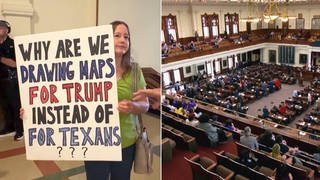
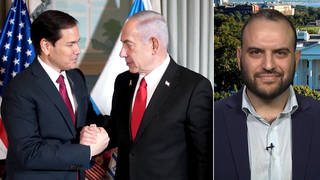
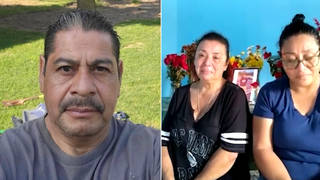
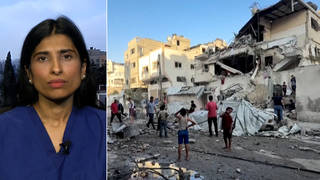
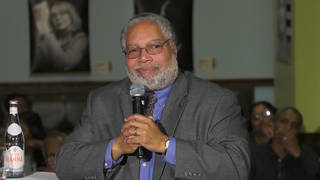


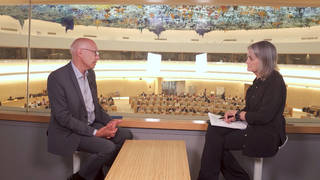

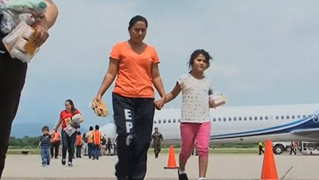
Media Options